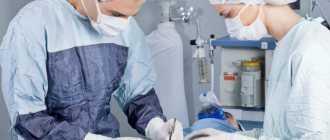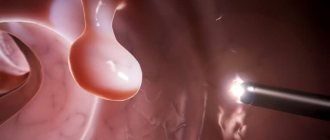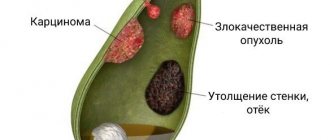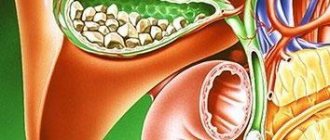Patients often come to an appointment with an ultrasound report of the gallbladder and are worried that gallbladder polyps have been found and are wondering what to do next. Surgeons offer surgical treatment. So should we operate or not?
Gallbladder polyps are benign tumors protruding into the lumen of a hollow organ. Unlike polyps of the stomach and intestines, polyps of the gallbladder are inaccessible to endoscopic methods of examination, and their histological examination is possible only in postoperative material.
General information
Having analyzed the pathologies of internal organs, we can conclude that gallbladder diseases occupy a fairly significant place in this list. However, there are also diseases that are not detected for a long time, even if the patient attends preventive examinations. Among these are polyps in the gallbladder, a relatively common disease. According to statistics, it is most often diagnosed in women over the age of 30. Against the backdrop of improvements in the overall quality of diagnostics, doctors often make this diagnosis recently. The main feature of this disease is the absence of pronounced clinical manifestations. In most cases, patients with polyps complain of pain of varying intensity in the right hypochondrium. If an infection joins the pathological process, then the symptoms resemble acute cholecystitis .
The ICD-10 code for gallbladder polyp is K82 (other gallbladder diseases). What are polyps in the gallbladder, is it dangerous, is it necessary to remove these formations and what treatment is appropriate in such a situation will be discussed in this article. In addition, the article provides the opinions of experts on why such a diagnosis is dangerous.
Surgical treatment of polyposis
Report on the master class by Prof. Puchkova K.V.
The absolute indication for surgery is the large size of the formation and the pain experienced by the patient. In addition, you should know that polyps that do not have a stalk tend to degenerate into malignant carcinomas. They are characterized by rapid growth and progression, which poses a threat to the patient's health. In this case, immediate surgery is the only solution.
The scope of surgical intervention is discussed in each specific case individually. Indications for surgical intervention are polyps measuring 7 mm and above, as well as any size of polyp located in the neck of the gallbladder due to a sharp disruption of the function of the organ and the development of chronic cholecystitis.
Pathogenesis
The gallbladder is an organ that is located next to the liver. Accordingly, the liver synthesizes bile , which accumulates in the gallbladder, and during the digestion process it is released into the small intestine. Due to the influence of various factors, pathological growths called polyps appear inside the gallbladder. In almost 90% of cases they are safe. However, in other cases we are talking about so-called true polyps, which can sometimes be malignant.
It is still not known for certain why polyps appear in the gallbladder. Sometimes such formations are parasitic in nature. If parasites settle in the ducts of the gallbladder, a worm-like tumor may be identified as a polyp during ultrasound examination. The development of cholesterol polyps is associated with the accumulation of cholesterol .
Complications
Multiple polyps contribute to the degeneration of cells into malignant ones, then gallbladder cancer forms
Untreated cholesterol polyps can lead to serious complications. The most dangerous of them:
- Cholesterol stones. This occurs when the polyp remains inside the organ for a long time and becomes calcified. The next contraction of the walls of the bladder contributes to the separation of the stem of the formation.
- Blockage of ducts with stones. If a stone gets stuck in the bile duct, bile will not be able to leave the organ. This is fraught with rupture of the bladder walls, peritonitis and sepsis. Bilirubin accumulates in the patient's blood, as a result of which the skin turns yellow, that is, obstructive jaundice occurs. The patient requires urgent surgical intervention, without which he will die.
- Getting stones stuck in the sphincter of Oddi prevents enzymes from flowing from the pancreas to the bile. Therefore, acute pancreatitis begins, turning into pancreatic necrosis.
- Multiple polyps contribute to the degeneration of cells into malignant ones, then gallbladder cancer is formed.
Classification
Depending on the nature of such formations, the following types are determined:
- A cholesterol polyp is a formation that appears due to hyperplasia of the mucous membrane of the gallbladder. The name “cholesterol” is due to the fact that the polyp consists of cholesterol deposits. These are so-called false polyps, which respond to conservative treatment and completely resolve. However, ultrasound most often reveals a true polyp in this case, so diagnosis in this case is quite complicated. Develops against the background of fat metabolism disorders. By visiting this or that forum, you can find many stories about how such polyps were completely cured.
- Inflammatory – a consequence of the inflammatory reaction of the gallbladder mucosa. Develops as a proliferation of granulation tissue. These are peculiar pseudotumor formations that grow because the mucous membrane reacts to inflammation in this way. Also factors that provoke such formations are parasitic infections and calculi.
- Adenomatous is a benign formation that develops as a polyp-like growth of glandular tissue. In this case, there is an increased risk of developing a malignant tumor (in approximately 10% of cases).
- Papilloma is a benign formation that develops as papillary growths. However, when exposed to certain factors, such growths can become malignant.
Based on the number of growths, the following are determined:
- Singles.
- Multiple.
Accompanying illnesses
Calculous cholecystitis can accompany polyposis" src=»/images/1/-1-12.jpg» alt=»Calculous cholecystitis can accompany polyposis» width=»330″ height=»250″ />
Quite often, polyps cause pathological processes in neighboring organs - the pancreas and liver. Since polyposis can act as an infectious source that causes the development of an inflammatory process, biliary spasms, cholecystitis, pancreatitis, etc. often develop against the background of gall bladder polyps.
In general, among the pathologies accompanying polyposis, one can distinguish spasms of the bile ducts or dyskinesia, various forms of pancreatitis and cholecystitis, or cholelithiasis.
Causes of polyps in the gallbladder
Most often, the reasons for the appearance of such formations are associated with metabolic disorders. We are talking about lipid metabolism, leading to an increase in cholesterol levels in the blood. As a result, cholesterol is deposited on the walls of the gallbladder, forming false polyps.
However, other factors can determine the appearance of polyps:
- The presence of gallbladder pathologies associated with inflammation. Polyps often form in people with chronic cholecystitis , when the flow of bile into the duodenum is disrupted.
- Hereditary factor.
- Genetic anomalies.
- Hypatobinary pathology, which provokes dyskinesia of the gallbladder .
- Improper and irregular diet, abuse of food containing large amounts of cholesterol.
Education mechanism
If a large amount of cholesterol enters the blood, its excess remains in the bile
If a large amount of cholesterol enters the blood, its excess remains in the bile. First, macrophages try to capture it - cells that rid the body of foreign particles and decay products. But they are not able to remove all the cholesterol, so the fat cells attach to the walls of the organ and begin to grow.
If treatment is not started, the polyps will reach large sizes. When a polyp breaks away from the wall, it becomes a cholesterol stone and is clearly visible on ultrasound.
Symptoms of gallbladder polyps
Polyps in the gallbladder present with nonspecific symptoms. Very often, patients are completely free of any complaints, and the formation itself is discovered by chance, during a preventive examination or ultrasound of the abdominal cavity when diagnosing other diseases. Such studies can be carried out if a person complains of a feeling of heaviness, flatulence , belching, etc.
Symptoms of a cholesterol polyp appear along with signs of other diseases. In this case, the most dangerous condition is when such formations are located in the neck or ducts of the gallbladder. With such localization, the normal process of bile outflow may be disrupted, which leads to the development of obstructive jaundice .
Thus, symptoms that indicate this disease may include the following:
- Jaundice, in which yellowing of the skin is visually detected. This indicates an increase in the level of bilirubin in the body.
- If there are mechanical obstacles to the normal outflow of bile, it can penetrate into the blood. As a result, blood pressure increases, skin itching, nausea and vomiting are noted.
- Liver spasms – develop in the area of the right hypochondrium. This symptom is typical for polyps with long stalks. This condition can cause very severe pain and requires immediate treatment.
In general, the development of such formations can lead to disruption of the liver, gallbladder, and pancreas. Due to inflammatory processes, cholecystitis, pancreatitis and corresponding symptoms can develop.
Who is at risk from polyps?
Polyps are most often found in middle-aged and elderly people. Their appearance is expected when infected with Helicobacter pylori, since this bacterium increases the risk of developing chronic gastritis, and gastritis is considered one of the causes of polyps.
Multiple polyps are five times more likely to cause malignancy than single polyps. There is a close relationship between the size of the polyp and the risk of malignant neoplasm - a formation with a diameter of 1.5 cm is repeated in malignant disease in 6.8% of cases, and with a diameter of 3 cm - in 73.7%. Polyps with flat stalks are three times more likely to become cancerous than polyps with long stalks.
Tests and diagnostics
The main method for diagnosing the disease is ultrasound. In the gallbladder, a polyp is defined as a round or oval formation.
Types of polyps
In addition, if necessary, other studies are used:
- Endoscopic ultrasonography (endosonography) - makes it possible to more accurately determine the location of the formation and its structure.
- Magnetic resonance cholangiography - a study that allows not only to determine the location and characteristics of the polyp, but also to identify or exclude other diseases of the gallbladder.
- Computed tomography - in the process of such a study, it is possible, among other things, to differentiate space-occupying formations in the liver.
Symptoms
Manifestations of polyposis are not specific and are similar to the symptoms of other gall diseases:
- Pain in the right side. They can be dull, periodic or acute like colic. Caused by stagnation of bile.
- Abdominal cramps after eating fatty foods, alcohol, or physical exercise. During spasms, pressure may rise and an attack of tachycardia may begin.
- Digestive disorders: diarrhea with an admixture of fats in the stool, nausea, vomiting, bitter belching.
- If the polyp is large, the skin of the abdomen turns yellowish and begins to itch and peel.
Treatment of polyps in the gallbladder with folk remedies
Very often, people with this pathology look for the answer to the question of how to stop the growth of a polyp in reference books on traditional medicine. It should be noted that not a single folk method can stop the growth of education and save the patient from the problem. Therefore, folk remedies can be treated in parallel with the main therapy and only if they are approved by the doctor.
- Celandine . 1 tsp. pour a glass of boiling water over the herbs and strain after two hours. Drink 2 tbsp before meals. l. three times a day.
- Chamomile with celandine . 20 g of celandine and chamomile herbs mixed in equal proportions should be poured with 200 ml of boiling water and left for 6 hours. Strain and drink 20 ml three times a day. The drug is taken for a month, after which a break is taken for a month and treatment is resumed.
- Herbal infusion . To prepare it, mix 20 g of St. John's wort, plantain, immortelle, coltsfoot, corn silk, knotweed, shepherd's purse, blackberries, and strawberries. To this mixture add 15 g of string and dill seeds, as well as 40 g of rose hips. Mix everything, take 2 tbsp. l. mixture and add 0.5 liters of water. Leave for half an hour, drink 100 ml before meals three times a day for a month.
Holiday recipes
If non-surgical treatment does not help, doctors resort to surgery
Diet foods can be very tasty. Some dishes will decorate the holiday table, which will equally please both those on a diet and completely healthy guests.
Meat casserole with potatoes
Salt 1 kilogram of low-fat minced chicken and mix well with a little milk, prepare mashed potatoes (1 kilogram), grate 150 grams of hard cheese on a coarse grater, chop some herbs.
The prepared products should be placed in layers in a greased baking dish, the top layer should be cheese, and placed in a preheated oven for 60-70 minutes.
Transfer the slightly cooled casserole to a plate, cut into pieces, sprinkle with herbs and serve.
Meat baked in the oven
Meat for baking will need to be prepared at home, since store-bought semi-finished products are usually generously sprinkled with pepper and thickly coated with mayonnaise or other fatty sauce.
A piece of meat must be cut lengthwise almost to the end, salted on the cut and beaten properly, greased with low-fat sour cream and wrapped so that it resembles a whole piece. If necessary, you can tie it with twine. Coat the meat with sour cream and refrigerate overnight. Transfer the meat to a baking sheet and place in the oven for 1-2 hours.
Readiness is checked with a knitting needle or knife; in the finished dish, clear juice is released from the cut. Meat can be cooked in foil; it will be softer and juicier, but it is better not to cover the top part so that a crust appears.
Prevention
To avoid the development of this pathology and prevent problems associated with it, it is important to adhere to the following rules of prevention:
- If you have a genetic predisposition to this disease, undergo preventive examinations regularly (once every six months).
- Take measures to normalize fat metabolism. To do this, it is necessary to adjust the diet in order to reduce the amount of fats and simple carbohydrates in it, as well as lead an active lifestyle. A sedentary and inactive lifestyle provokes stagnation of bile.
- Treat gastrointestinal diseases in a timely manner. In case of inflammatory diseases, immediately practice the treatment regimen prescribed by the doctor.
- Do not abuse alcohol.
Advantages and disadvantages
| pros | Minuses |
|
|
Diet
Diet for polyps in the gallbladder
- Efficacy: no data
- Timing: permanently/from 3 to 6 months after surgery
- Cost of products: 1300-1500 rubles. in Week
Proper nutrition is an important element in the treatment of gallbladder polyps. Therefore, when confirming such a diagnosis, it is very important to adhere to some general recommendations:
- Don't skip breakfast.
- Eat small meals - 5-6 times a day. In this case, one serving should weigh approximately 200 g.
- Do not snack on unhealthy foods such as fast food.
- Avoid fatty and fried foods and simple carbohydrates in favor of healthier foods.
- Drinking regime is also important - you should consume a sufficient amount of water per day - about 1.5 liters.
- Food should be consumed warm.
- The amount of salt should not exceed 1 tsp. in a day.
- It is recommended to eat boiled and steamed foods, and you can also bake food.
It is recommended to exclude the following foods from the diet:
- Fatty broths.
- Fatty dairy products.
- Confectionery.
- Corn.
- Garlic, radishes, onions, spinach, legumes.
- Soda, store-bought juices.
- Chocolate, cocoa, coffee.
- Marinades.
- Alcohol.
- Mushrooms.
- Spicy dishes.
- Smoked meats.
Authorized Products
The diet for polyps in the gallbladder in the preoperative period and during the recovery stage after their removal includes dried wheat bread/white crackers, and, if tolerated, rye bread or made from peeled flour. Soups are prepared in weak vegetable broths with the addition of vegetables, cereals and noodles, with the addition of unsalted butter or low-fat sour cream without frying.
To prepare second courses, it is recommended to use veal, lean beef, rabbit meat, poultry (chicken, turkey) boiled/baked, chopped or in pieces. The diet can include low-fat white river/sea fish with vegetables and boiled seafood. Vegetables are baked, boiled or steamed and served in the form of salads, vinaigrettes, caviar, seasoned with vegetable oils or sour cream.
Chicken eggs - exclusively in the form of steam omelettes or boiled soft-boiled, preferably without yolks. The diet should include low-fat fermented milk products: kefir, acidophilus, yogurt, low-fat cottage cheese (in the form of casseroles and natural). Milk may only be used as an additive to dishes and tea. Sour cream and butter - as a seasoning for ready-made dishes.
Cereals should be well boiled. For spices, you can use garden herbs and add cinnamon to sweet dishes. As a dessert, you can include non-acidic fruits/berries in any form, marmalade, jam, honey in your diet. It is better to partially replace sugar with xylitol. Consume free liquid in sufficient quantities, mainly in the form of tea/coffee with milk, rosehip infusion, vegetable/fruit juices, non-carbonated mineral water.
Table of permitted products
| Proteins, g | Fats, g | Carbohydrates, g | Calories, kcal | |
Vegetables and greens | ||||
| eggplant | 1,2 | 0,1 | 4,5 | 24 |
| zucchini | 0,6 | 0,3 | 4,6 | 24 |
| cabbage | 1,8 | 0,1 | 4,7 | 27 |
| broccoli | 3,0 | 0,4 | 5,2 | 28 |
| carrot | 1,3 | 0,1 | 6,9 | 32 |
| cucumbers | 0,8 | 0,1 | 2,8 | 15 |
| salad pepper | 1,3 | 0,0 | 5,3 | 27 |
| parsley | 3,7 | 0,4 | 7,6 | 47 |
| iceberg lettuce | 0,9 | 0,1 | 1,8 | 14 |
| tomatoes | 0,6 | 0,2 | 4,2 | 20 |
| pumpkin | 1,3 | 0,3 | 7,7 | 28 |
| dill | 2,5 | 0,5 | 6,3 | 38 |
Fruits | ||||
| bananas | 1,5 | 0,2 | 21,8 | 95 |
| apples | 0,4 | 0,4 | 9,8 | 47 |
Nuts and dried fruits | ||||
| raisin | 2,9 | 0,6 | 66,0 | 264 |
| dried figs | 3,1 | 0,8 | 57,9 | 257 |
| dried apricots | 5,2 | 0,3 | 51,0 | 215 |
| dried apricots | 5,0 | 0,4 | 50,6 | 213 |
| prunes | 2,3 | 0,7 | 57,5 | 231 |
Cereals and porridges | ||||
| buckwheat | 4,5 | 2,3 | 25,0 | 132 |
| oatmeal | 3,2 | 4,1 | 14,2 | 102 |
| pearl barley porridge | 3,1 | 0,4 | 22,2 | 109 |
| rice | 6,7 | 0,7 | 78,9 | 344 |
Flour and pasta | ||||
| pasta | 10,4 | 1,1 | 69,7 | 337 |
| buckwheat noodles | 14,7 | 0,9 | 70,5 | 348 |
Bakery products | ||||
| bran bread | 7,5 | 1,3 | 45,2 | 227 |
| whole grain bread | 10,1 | 2,3 | 57,1 | 295 |
Confectionery | ||||
| jam | 0,3 | 0,2 | 63,0 | 263 |
| jelly | 2,7 | 0,0 | 17,9 | 79 |
| marshmallows | 0,8 | 0,0 | 78,5 | 304 |
| milk candies | 2,7 | 4,3 | 82,3 | 364 |
| fondant candies | 2,2 | 4,6 | 83,6 | 369 |
| fruit and berry marmalade | 0,4 | 0,0 | 76,6 | 293 |
| paste | 0,5 | 0,0 | 80,8 | 310 |
| Maria cookies | 8,7 | 8,8 | 70,9 | 400 |
Raw materials and seasonings | ||||
| honey | 0,8 | 0,0 | 81,5 | 329 |
| sugar | 0,0 | 0,0 | 99,7 | 398 |
Dairy | ||||
| kefir 1.5% | 3,3 | 1,5 | 3,6 | 41 |
| Ryazhenka | 2,8 | 4,0 | 4,2 | 67 |
Cheeses and cottage cheese | ||||
| cottage cheese | 17,2 | 5,0 | 1,8 | 121 |
| cottage cheese 1% | 16,3 | 1,0 | 1,3 | 79 |
Meat products | ||||
| beef | 18,9 | 19,4 | 0,0 | 187 |
| rabbit | 21,0 | 8,0 | 0,0 | 156 |
Sausages | ||||
| boiled diet sausage | 12,1 | 13,5 | 0,0 | 170 |
| boiled milk sausage | 11,7 | 22,8 | 0,0 | 252 |
| milk sausages | 12,3 | 25,3 | 0,0 | 277 |
Bird | ||||
| boiled chicken breast | 29,8 | 1,8 | 0,5 | 137 |
| boiled chicken drumstick | 27,0 | 5,6 | 0,0 | 158 |
| boiled turkey fillet | 25,0 | 1,0 | — | 130 |
Eggs | ||||
| soft-boiled chicken eggs | 12,8 | 11,6 | 0,8 | 159 |
Fish and seafood | ||||
| flounder | 16,5 | 1,8 | 0,0 | 83 |
| pollock | 15,9 | 0,9 | 0,0 | 72 |
| cod | 17,7 | 0,7 | — | 78 |
| hake | 16,6 | 2,2 | 0,0 | 86 |
Oils and fats | ||||
| butter | 0,5 | 82,5 | 0,8 | 748 |
| olive oil | 0,0 | 99,8 | 0,0 | 898 |
| sunflower oil | 0,0 | 99,9 | 0,0 | 899 |
Non-alcoholic drinks | ||||
| water | 0,0 | 0,0 | 0,0 | — |
| mineral water | 0,0 | 0,0 | 0,0 | — |
| green tea | 0,0 | 0,0 | 0,0 | — |
Juices and compotes | ||||
| apricot juice | 0,9 | 0,1 | 9,0 | 38 |
| carrot juice | 1,1 | 0,1 | 6,4 | 28 |
| peach juice | 0,9 | 0,1 | 9,5 | 40 |
| plum juice | 0,8 | 0,0 | 9,6 | 39 |
| tomato juice | 1,1 | 0,2 | 3,8 | 21 |
| pumpkin juice | 0,0 | 0,0 | 9,0 | 38 |
| rose hip juice | 0,1 | 0,0 | 17,6 | 70 |
| * data is per 100 g of product | ||||










